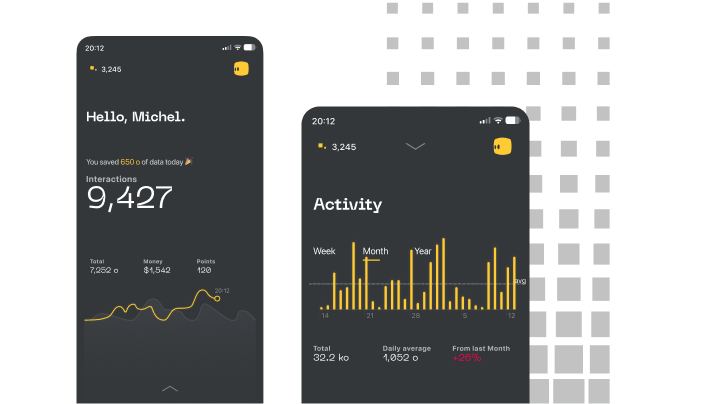Léthé
Digital Identity Protection Reimagined.
Prescient Design at the Digital Privacy Frontier
In early 2018, as the Cambridge Analytica scandal unfolded and GDPR implementation loomed, I identified a critical emerging need: people were increasingly vulnerable in the digital space yet lacked both awareness and tools to protect themselves. While tech giants continued harvesting personal data at unprecedented scale, I recognized that true innovation would mean creating solutions that empowered individuals rather than exploited them.
Léthé—named after the mythological river of forgetting—emerged as my graduation project, but it represented much more: a vision for how technology could respect human dignity in the digital age. Little did I know that this project would anticipate major privacy initiatives from companies like Apple, Google, and Brave in the years that followed.
The Challenge
Digital identity protection in 2018 presented a multi-faceted challenge:
- Awareness Gap – Most users had limited understanding of how their data was being collected and monetized
- Technical Complexity – Privacy protection tools were often too complex for average users
- Engagement Barrier – Educational content about digital privacy typically failed to engage users meaningfully
- Control Paradox – People felt simultaneously concerned about privacy yet powerless to protect themselves
The fundamental question became: How might we design a solution that not only protects digital identity but also educates and empowers users in an engaging way?
Source: The GuardianThe Approach
I developed a comprehensive discovery process to ensure my solution would address authentic user needs:
1. Contextual Analysis
First, I conducted a PESTEL analysis (Political, Economic, Social, Technological, Environmental, Legal) to understand digital privacy from multiple perspectives. This revealed that while legal and political awareness was growing, social understanding remained limited.
2. User Research
To validate initial findings, I implemented a dual research approach:
- Quantitative: Survey with over 1,000 responses about digital privacy attitudes and awareness
- Qualitative: In-depth street interviews capturing emotional responses to privacy concerns
The research confirmed a critical insight: users who learned more about data privacy became increasingly concerned, yet still felt powerless to change their situation—creating a dangerous cycle of awareness followed by resignation.
3. User Modeling
Based on research findings, I developed:
- Four distinct user personas representing different privacy awareness levels
- Comprehensive customer journey maps identifying critical touchpoints and emotional states
- Opportunity spaces where intervention could be most effective
4. Concept Development
I explored multiple solution directions, including:
- A privacy-focused web browser
- A secure search engine
- A browser extension for data leak detection
- A standalone application
Through iterative evaluation against user needs and technical feasibility, I determined that an educational yet playful mobile application would create the best foundation for my Minimum Viable Product.
The Solution
Léthé emerged as a comprehensive digital identity protection platform with a distinctively approachable personality:
Playful Branding
Rather than leaning into the fear-based messaging common in security products, I developed a friendly, accessible brand identity:
- Warm, inviting color palette contrasting with typical security product aesthetics
- Clear, jargon-free language that empowered rather than intimidated
- Hyde, a friendly mascot character who guides users through their privacy journey
Core Functionality
Data Manager
The central dashboard visualizes:
- App and website interaction frequency
- Estimated data leakage volume (in bytes)
- Projected monetary value of personal data to third parties
- Longitudinal tracking to visualize privacy improvement over time
Search Bot
Inspired by web crawlers, this tool:
- Aggregates publicly available information about the user
- Demonstrates how easily digital identities can be reconstructed
- Creates tangible awareness of digital footprints
- Empowers users with knowledge of their visible data
Play & Learn
A gamified education system that:
- Transforms complex privacy concepts into engaging challenges
- Uses achievement mechanics to encourage continuous engagement
- Creates positive reinforcement for privacy-protective behaviors
- Builds competency through progressive skill development
The final design balanced educational depth with approachable interaction, making digital privacy protection accessible to users regardless of technical background.
Impact & Legacy
While Léthé was a graduation project rather than a commercial product, its impact extended beyond academic evaluation:
- Industry Recognition – The project received positive feedback from professionals at my graduation exhibition
- Concept Validation – Major companies later implemented similar concepts:
- Apple’s “Ask Not To Track” and “Hide My Email” features
- Brave’s privacy-focused browser
- Google’s 2022 announcement of similar privacy control tools
Most significantly, Léthé represented an early exploration of what has since become a mainstream concern in digital product design: how to create technology that respects human autonomy and dignity.
Key Insights
This project reinforced several principles that continue to guide my design approach:
-
Anticipate user needs before they become obvious – By identifying privacy concerns before they went mainstream, I positioned myself at the leading edge of design thinking
-
Balance education with engagement – Technical solutions fail if users don’t understand or engage with them; design must address both aspects
-
Humanize complex problems – The friendly mascot and gamification transformed an intimidating topic into an approachable experience
-
Ethics and innovation are complementary – The most forward-thinking design often emerges when we prioritize human dignity alongside technical capability
Léthé demonstrates that designer-entrepreneurs have a unique opportunity—and responsibility—to envision technology that serves humanity’s best interests rather than exploiting its vulnerabilities.



